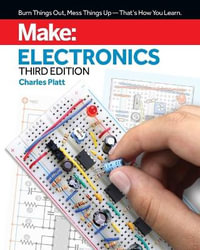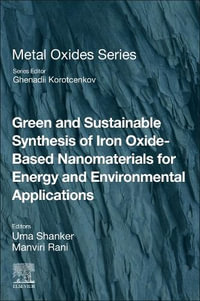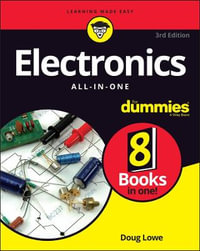
Electrical Power System Essentials
By: Pieter Schavemaker, Lou van der Sluis
Hardcover | 15 May 2025 | Edition Number 3
At a Glance
384 Pages
26.0 x 18.5 x 2.5
Hardcover
RRP $155.95
$118.75
24%OFF
or 4 interest-free payments of $29.69 with
orShips in 5 to 7 business days
A highly accessible resource covering the basics of the design and operation of electrical power systems with minimal technical background required
Electrical Power System Essentials delivers a thorough introduction to the electrical power system and its functioning, and the changes that come with the worldwide energy transition process. This revised and updated Third Edition includes new material on HVDC developments, electricity markets, capacity calculation (NTC and flow-based), power system protection, and energy storage. Discussions on how renewable sources play a more dominant role in the generation of electrical energy and the effects they have on the control and operation of the grid and electricity markets are also included.
Written in the accessible style that has made previous editions so popular with readers, this book restricts math content to the Appendix in order to maintain an easy reading experience of the main text while still providing complete coverage. A companion website includes downloadable teaching materials, and accessory videos are viewable on the Wiley website (www.wiley.com/go/powersystem3e) and YouTube (https://www.youtube.com/playlist?list=PLvaU1SY38TUV8JTwkf1taN-w_bQbCD0Ad).
Topics discussed in the book include:
- Generation of electric energy, covering nuclear fission, wind energy and wind turbine concepts, hydropower and pumped storage, and solar power
- Electricity markets, covering gas scarcity, its influence on the marginal price of electricity, and negative energy prices
- Future power systems, covering higher harmonics, increased use of cables instead of overhead transmission lines, distributed generation and power-electronic interfaces
- Transmission of electric energy, covering DC circuit breakers, wide area measurement systems, and distribution networks
Electrical Power System Essentials is a perfect textbook for second- and third-year undergraduate electrical engineering students who need an accessible course text introducing concepts in power system engineering. The text is also valuable for other students and professionals who require an up-to-date reference on power systems technology.
Preface xi
List of Abbreviations xvii
List of Symbols xix
About the Companion Websitexxi
1 Introduction to Power System Analysis 1
1.1 Introduction 1
1.2 Scope of the Material 1
1.3 General Characteristics of Power Systems 4
1.3.1 AC Versus DC Systems 4
1.3.1.1 Shape of the Alternating Voltage 5
1.3.1.2 Sinusoidal Alternating Voltage 6
1.3.2 50 and 60 Hz Frequency 7
1.3.3 Balanced Three-phase Systems 9
1.3.3.1 Power Considerations 10
1.3.3.2 Rotating Magnetic Field 12
1.3.4 Voltage Levels 15
1.3.4.1 Line-to-line and Line-to-neutral Voltages 16
1.4 Phasors 17
1.4.1 Network Elements in the Phasor Domain 19
1.4.2 Calculations in the Phasor Domain 21
1.5 Equivalent Line-to-neutral Diagrams 24
1.6 Power in Single-phase Circuits 26
1.6.1 Active and Reactive Power 26
1.6.2 Complex Power 29
1.6.3 Power Factor 33
1.7 Power in Three-phase Circuits 34
1.8 Per-unit Normalization 35
1.9 Power System Structure 39
Problems 40
References 42
2 Generation of Electric Energy 43
2.1 Introduction 43
2.2 Thermal Power Plants 44
2.2.1 The Principles of Thermodynamics 45
2.3 Nuclear Power Plants 49
2.3.1 Nuclear Fission 50
2.3.2 Nuclear Fusion 52
2.4 Renewable Energy 53
2.4.1 Wind Energy and Wind Turbine Concepts 53
2.4.2 Hydropower and Pumped Storage 56
2.4.3 Solar Power 58
2.4.4 Geothermal Power 61
2.5 The Synchronous Machine 63
Problems 70
References 71
3 The Transmission of Electric Energy 73
3.1 Introduction 73
3.2 Transmission and Distribution Network 74
3.3 Network Structures 76
3.4 Substations 78
3.5 Substation Concepts 80
3.5.1 Single Bus System 81
3.5.2 Double Bus System 81
3.5.3 Polygon Bus System 82
3.5.4 One-and-a-half Circuit Breaker Concept 82
3.6 Protection of Transmission and Distribution Networks 83
3.6.1 Protective Relay Operating Principles 84
3.6.2 Fuses 88
3.6.3 Circuit Breakers 89
3.6.4 The Switching Arc 91
3.6.5 Oil Circuit Breakers 92
3.6.6 Air-blast Circuit Breakers 93
3.6.7 SF 6 Circuit Breakers 93
3.6.8 Vacuum Circuit Breakers 94
3.6.9 dc Circuit Breakers 96
3.6.9.1 Active commutation 97
3.6.9.2 Passive commutation 97
3.6.9.3 Hybrid technology 97
3.7 Surge Arresters 98
3.8 Transformers 99
3.8.1 Phase Shifts in Three-phase Transformers 103
3.8.2 The Magnetizing Current 106
3.8.3 Transformer Inrush Current 108
3.8.4 Open-circuit and Short-circuit Tests 109
3.9 Power Carriers 110
3.9.1 Overhead Transmission Lines 112
3.9.1.1 Insulators 112
3.9.1.2 Bundled conductors 113
3.9.1.3 Galloping lines 118
3.9.1.4 Ground Wires or Shield Wires 120
3.9.1.5 Transposition 122
3.9.2 Underground Cables 123
3.9.2.1 Plastic insulation 126
3.9.2.2 Paper–oil insulation 126
3.9.3 Gas-insulated Transmission Lines 130
3.10 SF 6 Alternatives 130
3.11 High-voltage Direct Current Transmission 131
3.11.1 From AC to dc 134
Problems 138
References 139
4 The Utilization of Electric Energy 141
4.1 Introduction 141
4.2 Types of Load 142
4.2.1 Mechanical Energy 143
4.2.1.1 Synchronous Motors 144
4.2.1.2 Induction Motors 145
4.2.2 Light 148
4.2.3 Heat 149
4.2.4 dc Electrical Energy 149
4.2.5 Chemical Energy 152
4.3 Classification of Grid Users 152
4.3.1 Residential Loads 153
4.3.2 Commercial and Industrial Loads 154
4.3.3 Electric Railways 155
Problems 157
Reference 158
5 Power System Control 159
5.1 Introduction 159
5.2 Basics of Power System Control 161
5.3 Active Power and Frequency Control 163
5.3.1 Primary Control 163
5.3.2 Secondary Control or Load Frequency Control 168
5.4 Voltage Control and Reactive Power 170
5.4.1 Generator Control (Automatic Voltage Regulator) 170
5.4.2 Tap-changing Transformers 172
5.4.3 Reactive Power Injection 174
5.4.3.1 Static Shunt Capacitors and Reactors 174
5.4.3.2 Synchronous Compensators 174
5.4.3.3 Static Var Compensator 175
5.4.3.4 Static Synchronous Compensator 176
5.5 Control of Transported Power 178
5.5.1 Controlling Active Power Flows 178
5.5.1.1 The Phase Shifter 178
5.5.2 Controlling Reactive Power Flows 180
5.5.2.1 Static Series Capacitors 180
5.5.2.2 Thyristor-controlled Series Capacitor 181
5.5.2.3 Static Synchronous Series Compensator 182
5.5.3 Unified Power Flow Controller 182
5.6 Flexible AC Transmission Systems 184
Problems 185
References 187
6 Energy Management Systems 189
6.1 Introduction 189
6.2 Load Flow or Power Flow Computation 189
6.2.1 Load Flow Equations 191
6.2.2 General Scheme of the Newton–Raphson Load Flow 199
6.2.3 Decoupled Load Flow 203
6.2.4 dc Load Flow 207
6.2.4.1 Active Power Equations 207
6.2.4.2 Reactive Power Equations 208
6.3 Optimal Power Flow 209
6.4 State Estimator 210
6.4.1 General Scheme of the State Estimator 212
6.4.2 Bad Data Analysis 214
Problems 220
References 222
7 Electricity Markets 225
7.1 Introduction 225
7.2 Electricity Market Structure 226
7.2.1 Transmission and Distribution 226
7.2.2 Market Architecture 227
7.3 Market Clearing 228
7.4 Social Welfare 231
7.5 Market Coupling 232
7.6 Electricity Markets: Surplus and Scarcity 236
7.7 Allocation Mechanism and Zonal/Nodal Markets 238
7.8 Capacity Calculation 241
References 248
8 Future Power Systems 249
8.1 Introduction 249
8.2 Renewable Energy 250
8.3 Decentralized or Distributed Generation 252
8.4 Power Electronics in the Power System 255
8.4.1 Power-electronic Interfaces 255
8.4.2 System Inertia 256
8.5 Energy Storage 257
8.6 Blackouts and Chaotic Phenomena 259
8.6.1 Nonlinear Phenomena and Chaos 260
8.6.2 Blackouts 262
8.7 Wide Area Monitoring of Power Systems 269
8.7.1 Wide Area Measurement Systems in the Continental European Power System 270
References 272
A Maxwell’s Laws 273
A. 1 Introduction 273
A. 2 Power Series Approach to Time-varying Fields 275
A. 3 Quasi-static Field of a Parallel-plate Capacitor 276
A.3. 1 Quasi-static Solution 277
A.3. 2 Validity of the Quasi-static Approach 279
A. 4 Quasi-static Field of a Single-turn Inductor 280
A.4. 1 Quasi-static Solution 281
A.4. 2 Validity of the Quasi-static Approach 282
A. 5 Quasi-static Field of a Resistor 284
A.5. 1 Quasi-static Solution 285
A. 6 Circuit Modeling 287
Reference 288
B Power Transformer Model 289
B. 1 Introduction 289
B. 2 The Ideal Transformer 289
B. 3 Magnetically Coupled Coils 292
B.3. 1 Equivalence with the Ideal Transformer 294
B. 4 The Nonideal Transformer 295
B. 5 Three-phase Transformer 297
c Synchronous Machine Model 299
C. 1 Introduction 299
C. 2 The Primitive Synchronous Machine 299
C. 3 The Single-phase Synchronous Machine 304
C. 4 The Three-phase Synchronous Machine 309
C. 5 Synchronous Generator in the Power System 313
d Induction Machine Model 315
D.1 Introduction 315
D.2 The Basic Principle of the Induction Machine 315
D.2.1 A Single Rotor Winding 317
D.2.2 Two Rotor Windings 318
D.2.3 Rotating Rotor 320
D.3 The Magnetic Field in the Air Gap 321
D.3.1 Contribution of the Rotor Currents to the Air-gap Field 321
D.3.2 The Flux Linkage with the Stator Windings 324
D.4 A Simple Circuit Model for the Induction Machine 324
D.4.1 The Stator Voltage Equation 324
D.4.2 The Induction Machine as Two Magnetically Coupled Coils 325
D.4.3 A Practical Model of the Induction Machine 326
D.5 Induction Motor in the Power System 327
E The Representation of Lines and Cables 329
E.1 Introduction 329
E.2 The Long Transmission Line 329
E.3 The Medium-length Transmission Line 334
E.4 The Short Transmission Line 334
E.5 Comparison of the Three Line Models 335
E.6 The Underground Cable 336
F The Physics Behind the Maxwell Equations 337
F. 1 Introduction 337
F. 2 Ampere’s Law 337
F. 3 Faraday’s Law 338
F. 4 Maxwell’s Equations 339
Solutions 343
Further Reading 357
Index 359
ISBN: 9781394276080
ISBN-10: 1394276087
Published: 15th May 2025
Format: Hardcover
Language: English
Number of Pages: 384
Audience: Professional and Scholarly
Publisher: John Wiley & Sons (UK)
Country of Publication: GB
Edition Number: 3
Dimensions (cm): 26.0 x 18.5 x 2.5
Weight (kg): 0.87
Shipping
| Standard Shipping | Express Shipping | |
|---|---|---|
| Metro postcodes: | $9.99 | $14.95 |
| Regional postcodes: | $9.99 | $14.95 |
| Rural postcodes: | $9.99 | $14.95 |
Orders over $79.00 qualify for free shipping.
How to return your order
At Booktopia, we offer hassle-free returns in accordance with our returns policy. If you wish to return an item, please get in touch with Booktopia Customer Care.
Additional postage charges may be applicable.
Defective items
If there is a problem with any of the items received for your order then the Booktopia Customer Care team is ready to assist you.
For more info please visit our Help Centre.
You Can Find This Book In
This product is categorised by
- Non-FictionEngineering & TechnologyElectronics & Communications Engineering
- Non-FictionSciencePhysicsClassical MathematicsEnergy
- Non-FictionEngineering & TechnologyEnergy Technology & EngineeringElectrical Engineering
- Non-FictionEngineering & TechnologyEnergy Technology & EngineeringAlternative & Renewable Energy Sources & Technology






















